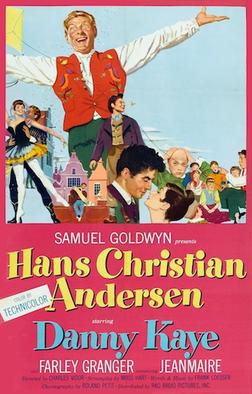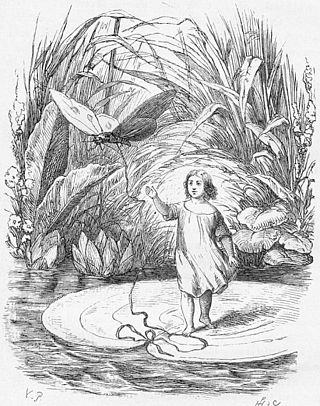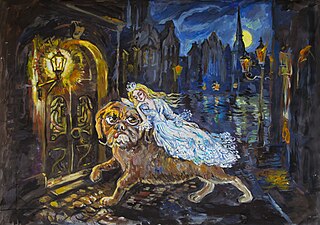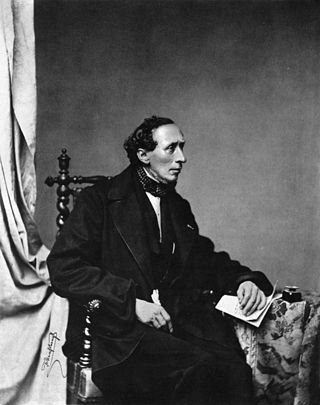
Hans Christian Andersen was a Danish author. Although a prolific writer of plays, travelogues, novels, and poems, he is best remembered for his literary fairy tales.

Hans Christian Andersen is a 1952 Hollywood musical film directed by Charles Vidor and produced by Samuel Goldwyn. The screenplay by Moss Hart and an uncredited Ben Hecht is based on a story by Myles Connolly.

"The Little Mermaid", sometimes translated in English as "The Little Sea Maid", is a fairy tale written by Danish author Hans Christian Andersen. Originally published in 1837 as part of a collection of fairy tales for children, the story follows the journey of a young mermaid princess who is willing to give up her life in the sea as a mermaid to gain a human soul.

"The Little Match Girl" is a literary fairy tale by Danish poet and author Hans Christian Andersen. The story, about a dying child's dreams and hope, was first published in 1845. It has been adapted to various media, including animated, live-action, and VR films as well as television musicals and opera.

Frederik Reesen Magle is a Danish composer, concert organist, and pianist. He writes contemporary classical music as well as fusion of classical music and other genres. His compositions include orchestral works, cantatas, chamber music, and solo works, including several compositions commissioned by the Danish royal family. Magle has gained a reputation as an organ virtuoso, and as a composer and performing artist who does not refrain from venturing into more experimental projects – often with improvisation – bordering jazz, electronica, and other non-classical genres.

"The Steadfast Tin Soldier" is a literary fairy tale by Hans Christian Andersen about a tin soldier's love for a paper ballerina. The tale was first published in Copenhagen by C.A. Reitzel on 2 October 1838 in the first booklet of Fairy Tales Told for Children. New Collection. The booklet consists of Andersen's "The Daisy" and "The Wild Swans". The tale was Andersen's first not based upon a folk tale or a literary model. "The Steadfast Tin Soldier" has been adapted to various media including ballet and animated film.

Thumbelina is a literary fairy tale written by the famous Danish author, Hans Christian Andersen. It was first published by C. A. Reitzel on 16 December 1835 in Copenhagen, Denmark, with "The Naughty Boy" and "The Travelling Companion" in the second installment of Fairy Tales Told for Children. Thumbelina is about a tiny girl and her adventures with marriage-minded toads, moles, and cockchafers. She successfully avoids their intentions before falling in love with a flower-fairy prince just her size.

"The Swineherd" is a literary fairy tale by Hans Christian Andersen about a prince who disguises himself as a swineherd to win an arrogant princess. The tale was first published December 20, 1841 by C. A. Reitzel in Copenhagen, Denmark in Fairy Tales Told for Children. New Collection. Third Booklet. The tale appears to be original with Andersen though similar tales are known. "The Swineherd" has been adapted to other media.

"The Red Shoes" is a literary fairy tale by Danish poet and author Hans Christian Andersen first published by C.A. Reitzel in Copenhagen 7 April 1845 in New Fairy Tales. First Volume. Third Collection. Other tales in the volume include "The Elf Mound" (Elverhøi), "The Jumpers" (Springfyrene), "The Shepherdess and the Chimney Sweep", and "Holger Danske".

"The Tinderbox" is a literary fairy tale by Hans Christian Andersen about a soldier who acquires a magic tinderbox capable of summoning three powerful dogs to do his bidding. When the soldier has one of the dogs transport a sleeping princess to his room, he is sentenced to death but cunningly summons the dogs to save his life.

"The Goblin at the Grocer's" is a fairy tale published in 1852 by Danish author Hans Christian Andersen, about a goblin who must choose between poetry or his Christmas porridge from a grocer.

This is a list of published works by Hans Christian Andersen. The list has been supplemented with a few important posthumous editions of his works; the year given in each entry refers to the first Danish edition. They are all in the public domain because Andersen died over 100 years ago.
"The Most Incredible Thing" is the final literary fairy tale by Danish poet and author Hans Christian Andersen (1805–1875). The story is about a contest to find the most incredible thing and the wondrous consequences when the winner is chosen. The tale was first published in an English translation by Horace Scudder, an American correspondent of Andersen's, in the United States in September 1870 before being published in the original Danish in Denmark in October 1870. "The Most Incredible Thing" was the first of Andersen's tales to be published in Denmark during World War II. Andersen considered the tale one of his best.

"The Snowman" is a literary fairy tale by Hans Christian Andersen about a snowman who falls in love with a stove. It was published by C.A. Reitzel in Copenhagen as Sneemanden on 2 March 1861. Andersen biographer Jackie Wullschlager describes the tale as a lyrical and poignant complement to Andersen's "The Fir-Tree" of December 1844.

Fairy Tales Told for Children. First Collection. is a collection of nine fairy tales by Hans Christian Andersen. The tales were published in a series of three installments by C. A. Reitzel between May 1835 and April 1837, and represent Andersen's first venture into the fairy tale genre.

"The Garden of Paradise" is a literary fairy tale by Hans Christian Andersen first published by C. A. Reitzel in Copenhagen, Denmark on 19 October 1839 with "The Flying Trunk" and "The Storks" in Fairy Tales Told for Children. New Collection. Second Booklet. Maximilian II of Bavaria read and liked the tale. Andersen biographer Jackie Wullschlager considers the story and its two companion pieces in the booklet as "grim". "The Garden of Paradise" ends with Death approaching a young prince and warning him to expiate his sins for, one day, he will come for him and "clap him in the black coffin".

New Fairy Tales. First Volume is a collection of nine fairy tales by Hans Christian Andersen. The tales were published in a series of three installments by C. A. Reitzel in Copenhagen, Denmark between November 1843 and April 1845.

Fairy Tales Told for Children. New Collection is a collection of ten fairy tales by Hans Christian Andersen. The tales were published in a series of three installments by C. A. Reitzel in Copenhagen, Denmark between October 1838 and December 1841.
Events from the year 1837 in Denmark.
"The Tallow Candle" is a 700-word literary fairytale by Danish writer Hans Christian Andersen (1805–1875).

















